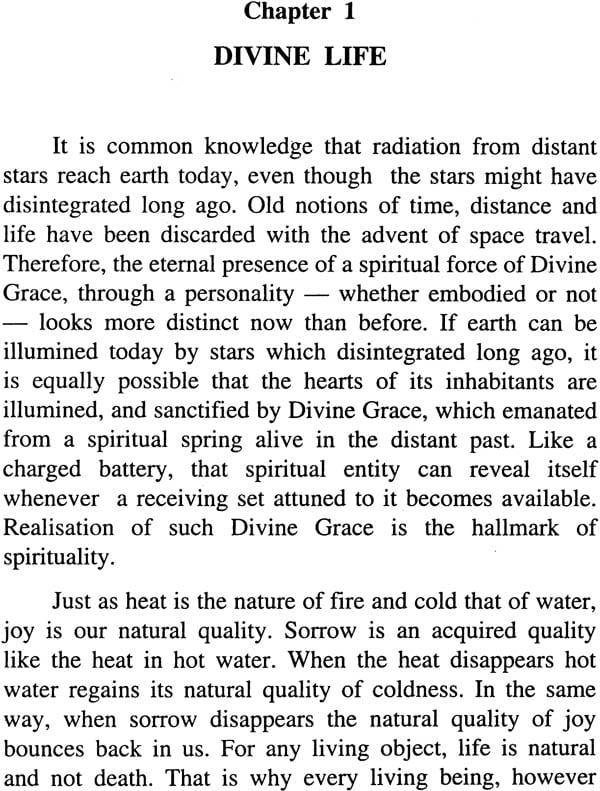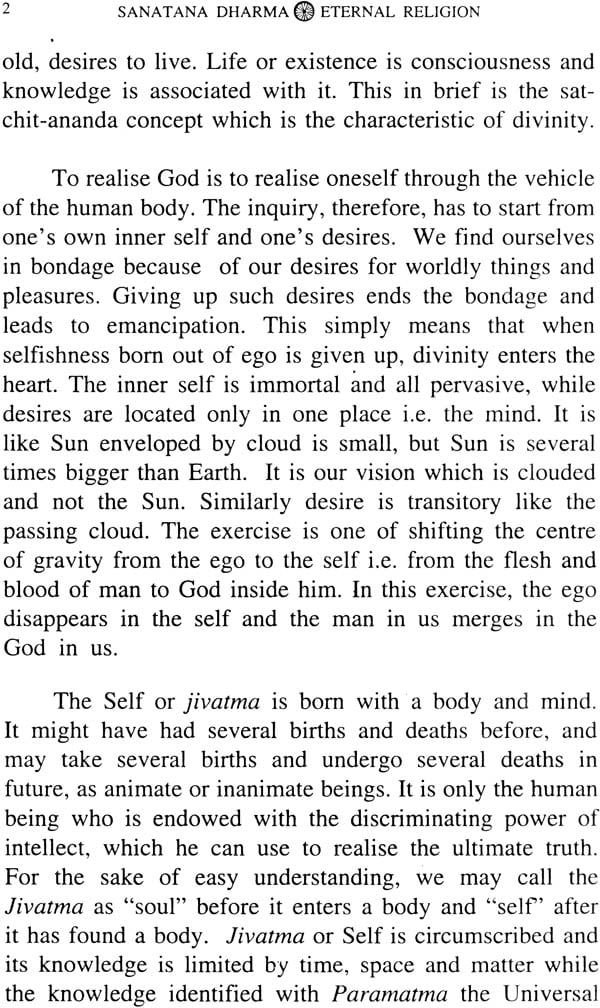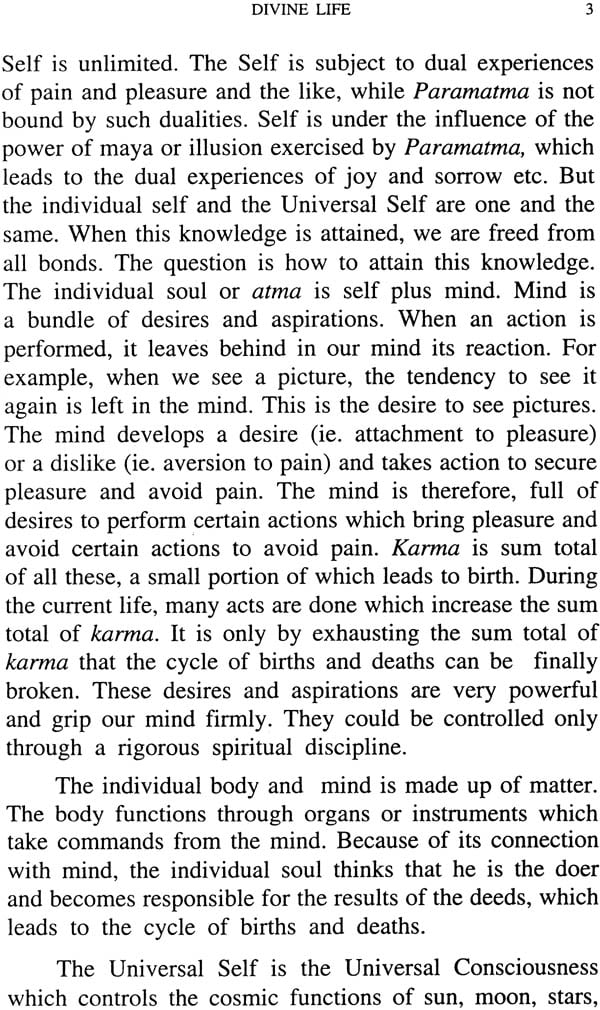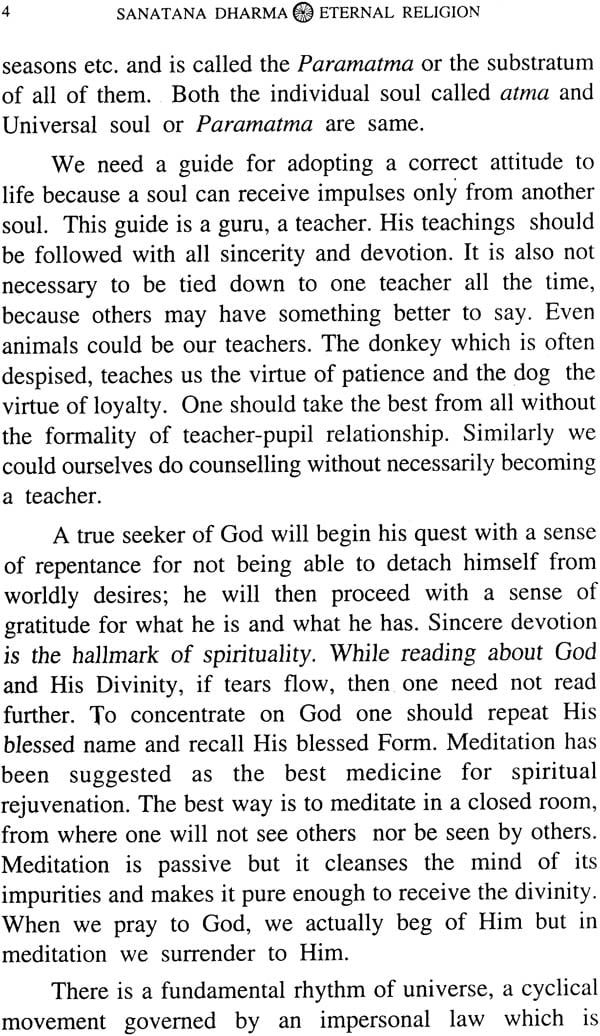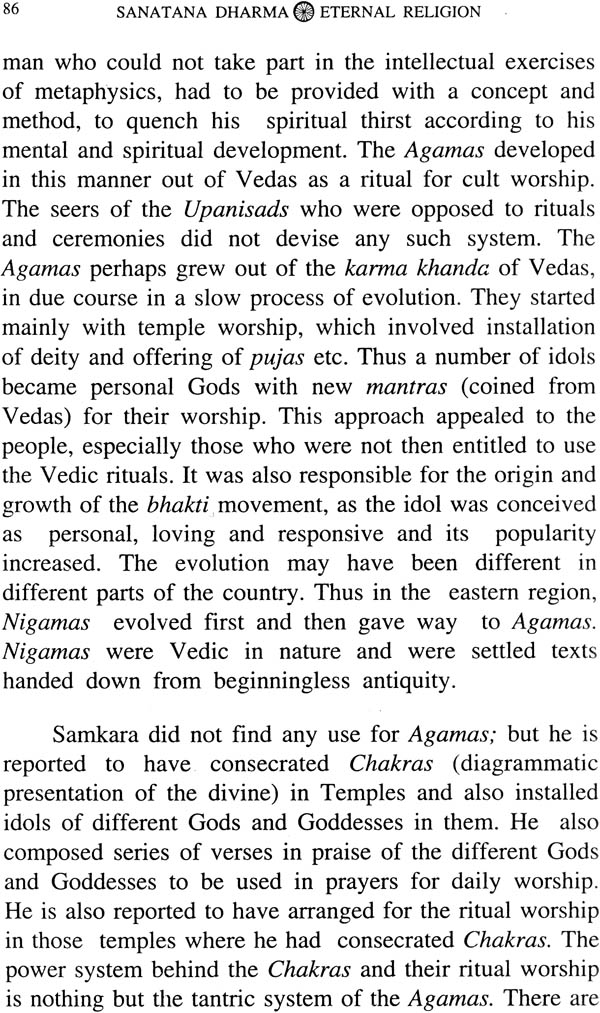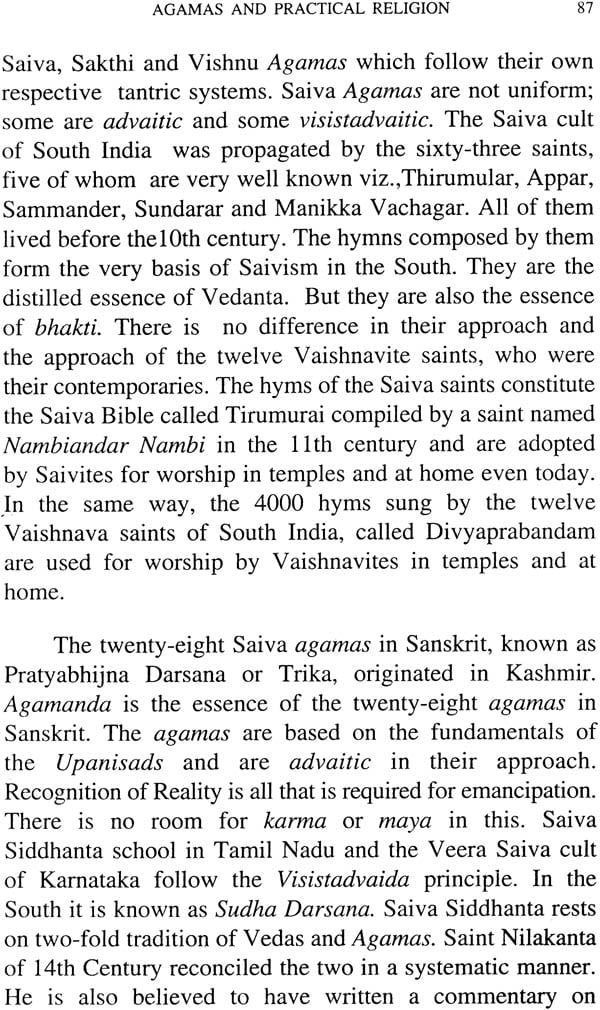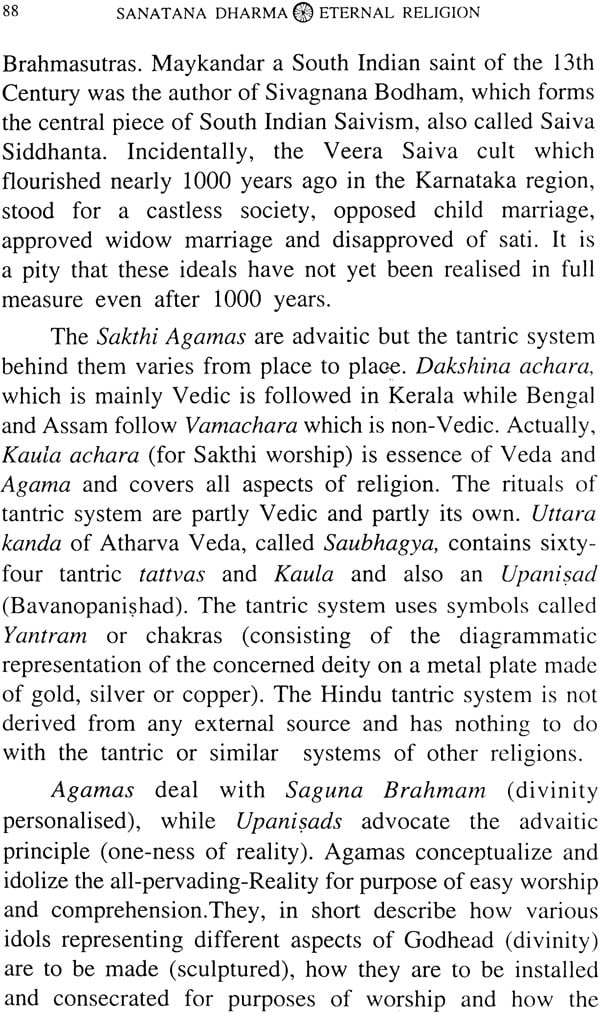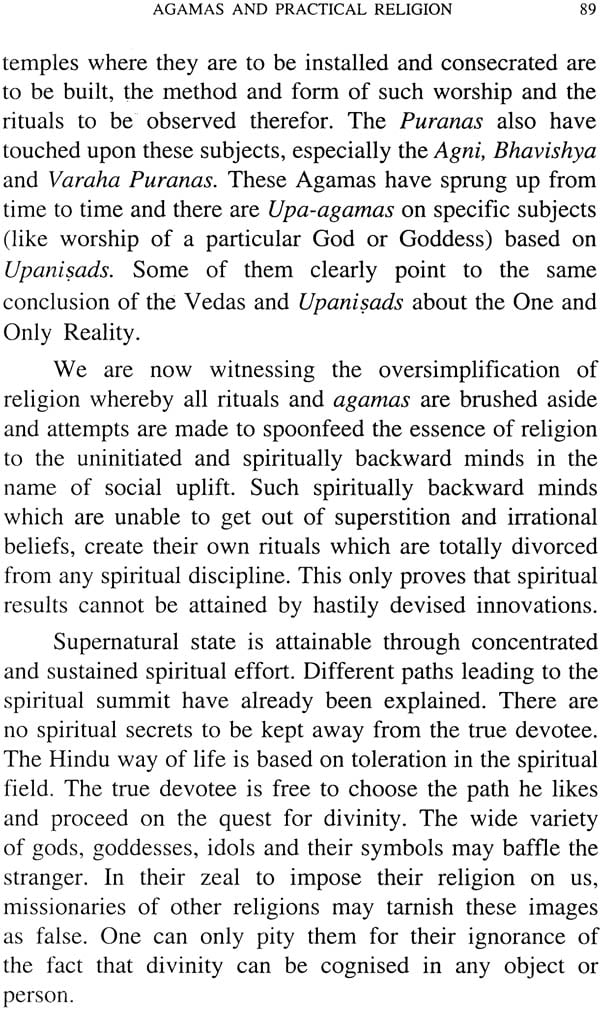
Sanatana Dharma and Eternal Religion
Book Specification
| Item Code: | NAI488 |
| Author: | T.R. Viswanathan |
| Publisher: | Bharatiya Vidya Bhavan |
| Language: | English |
| Edition: | 2000 |
| ISBN: | 817276197 |
| Pages: | 116 |
| Cover: | Paperback |
| Other Details | 8.5 X 5.5 inch |
| Weight | 190 gm |
Book Description
Born in Tirunilayi village of Palakkad district (Kerala State), TRV (76) is a post-graduate of the Madras University in humanities. After a brief stint at journalism, he joined the Government of India immediately after independence. Initially he served in the Ministry of External Affairs and moved on to several other Ministries including Commerce & Industry, Steel & Mines, Finance. He assisted the Administrative Reforms Commission for five years on subjects mainly relating to Personnel, Industry, Defence and Defence Production. He retired as Deputy Secretary from the Ministry of Steel and Mines. During the concluding period of his service, he had the unique opportunity to handle inter-connected subjects of geology, mining and metallurgy which took him to heights in Himalayas and depths in mines, one of the deepest being the Kolar in Mysore. This exposure left an everlasting spiritual thirst in him. The sacred peaks of Himalayas thereafter beckoned him frequently. From Amarnath in the western Himalayas to Arunachal Pradesh in the East, he did pilgrimage to several sacred places including Kailas and Manasarovar.
Spiritual awakening comes in several ways. Being in the immediate presence of spiritual leaders is one such. Such golden opportunities came his way from his childhood; with the Paramacharya immediately after his upanayanam at the age of eight, with Ramana Bhagavan for several weeks in 1942-43, with Swami Sivananda during 1947-60.
He spent the major part of his post-retirement life in spiritual pursuits which included pilgrimage to almost all holy places and sat-sangam with holy men.
He was given comprehensive initiation into Srividya by Swami Vimarsananda (who attained samadhi in Chennai recently), a few days before his retirement from Government service, which clinched his post- retirement life to one of spiritual pursuits only and bid goodbye to remunerative service.
He is now settled in Pune.
"Sanatana Dharma" is the religion of the Hindus. It is based on the Vedas and the scriptures and is very tolerant in nature. It is a fusion of the philosophy and religion adapted to the needs of the times. Its present form is the result of an evolution over the last 2000 years.
Sanatana Dharma is a way of life based on a particular frame of mind. It is not blind faith but is one of spirit of inquiry. It is one of learning correctly from a teacher who already knows, and after careful investigation, assess what has been learned as correct and try to follow it. It is not a static but a dynamic one covering all branches of knowledge including the highest, leading to emancipation.
Sanatana means eternal and dharma is generally translated as religion but it is much more than that because it begins before birth and survives death i.e. it covers the journey of the soul before and after it takes birth in a body and finally leaves that body. No other religion can make such a claim. Sanatana Dharma can, therefore, mean the religion of the Eternal One who is its founder. Its origin is anadi i.e. beginningless, not known and it has no end.
Even the Divine Incarnations have followed the principle that whatever comes into existence has to go out of existence. But this does not apply to Sanatana Dharma.
None of the ancient civilizations like Greek, Roman, Egyptian has survived today. All attempts at world domination have ended in failure because such civilizations and their leaders operated on either brute strength or perfection to the exclusion of ethics and morality. On the other hand Sanatana Dharma is founded on discipline and ethics. Even the demons of Puranas and Epics have followed the rules of war and chivalry. The moral supremacy of Sanatana Dharma has been acclaimed by western thinkers like Carlyle and Emerson.
Sanatana Dharma makes its followers sanatani (eternal). Several such sanatanists have made the country itself sanatani; it has survived all onslaughts on it and it will exist eternally. The Eternal One established the eternal dharma by following which the people and the country have become eternal. When we as individuals practice it, we are bound to prosper but when we deviate from it we are bound to fall.
The essence of the Hindu philosophy and religion lies hidden in several scriptures. Vedas, their main source were never written down. They were texts learnt orally from a teacher by the student. Due to the wearing out of the oral tradition by efflux of time, only some portions of Vedas have come down to us, and these have since been written down.
The beauty of the Hindu Religion is its variety, which offers a wide choice to the common man to begin his spiritual journey. This variety no doubt includes superfluous and unwanted aspects like mysticism, mythology, tradition, superstition and the 'like which have to be avoided to get the correct picture of the myriad aspects of the Religion.
There is confusion in the minds of many in regard to religion as a part of life. The necessity for religion itself is doubted by immature minds. The tremendous speed with which daily life is lived by many, leaves them very little time to devote to religion or even to think about it. It is human nature to think of religion or God only when faced with difficulties, failures and misery, at which stage we run to temples or seek remedies available with godmen or priests and the like. A proper understanding of our religion in the early stage of life will prevent such pathetic attempts.
Everyone should have a clear understanding of religion, so that the spiritual journey may begin at any time and in any manner one wants. Every one cannot become a gnani (man of real knowledge) or bhakta (devotee) by reading books unless the desire is there. The variety in religion is intended to provide choice to the individual, to choose his form of religious life according to his mental make up. But it is not a menu card. One cannot adopt several forms simultaneously - but that is what many people are doing now. If the choice is made in favour of idol worship for instance, the idol to be worshipped should be the Ishta Devata (personal God). Only by focusing attention on a single personal God, will it be possible to reach the goal set for a religious life. This has been demonstrated time and again by saints and sages in the past.
From time immemorial, divine personalities have left behind for our benefit the true picture of religion and have also presented a cogent explanation of "Divinity" in its diverse names and forms, so that everyone will have a wide choice, a choice to be exercised with discrimination, according to one's mental disposition. The ancient sages and teachers have never advocated a particular name or form for this purpose; it has been left to the sweet will of the individual. This is the ideal of tolerance preached and practised by the wise in our country. The exercise of the choice is a matter between the individual and his conscience, although some guidance is necessary for those not familiar with the subject. The object of this book is to offer such a guidance.
| Chapters | Page | |
| Introduction | vii | |
| 1 | Divinelife | 1 |
| 2 | Dharma | 8 |
| 3 | Mind | 11 |
| 4 | Spiritual freedom | 16 |
| 5 | Common features of religions | 21 |
| 6 | Vedas | 28 |
| 7 | Purana (mythology) and Itihasa (epics) | 35 |
| 8 | Upanisads | 41 |
| 9 | Six Systems of Vedic Philosophy | 44 |
| 10 | Bhagavad Geeta | 47 |
| 11 | Elements , and the Doctrines of Maya and Karma | 51 |
| 12 | The Suupernatural state | 56 |
| 13 | Saivism and Vaishnavism | 64 |
| 14 | Yoga of self-realisation | 67 |
| 15 | Bhakti yoga | 73 |
| 16 | Gnana yoga | 79 |
| 17 | Agamas and practical religion | 85 |
| 18 | Mother-worship | 92 |
| 19 | Mantra yoga | 94 |
| 20 | Kundalini yoga | 96 |
| 21 | Conclusion | 98 |
| 22 | Mental health care | 102 |
